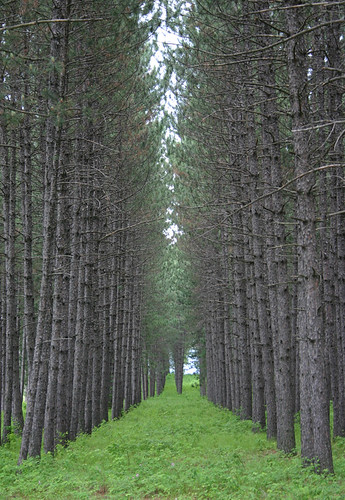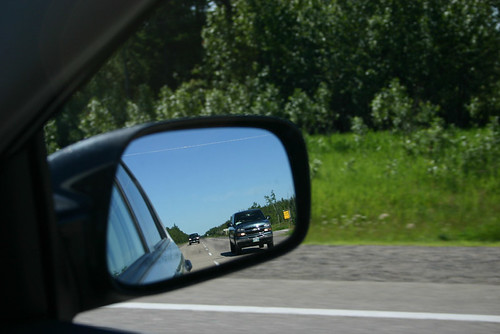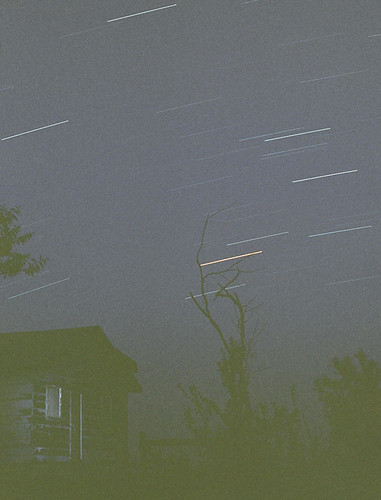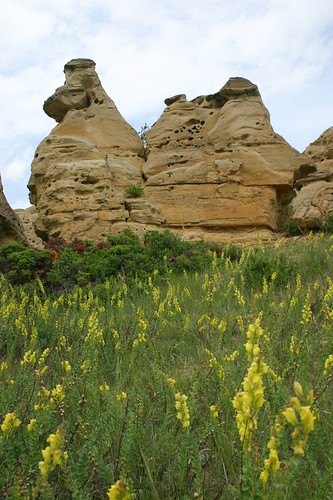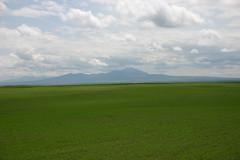June 17, 2006
It was a long stretch of driving today(819 kilometres,) but manageable. A good night's sleep will set me straight for another long haul tomorrow.
I don't have much to make note of today. I am now into the eastern time zone, which will carry me to the New Brunswick/Quebec border. With Manitoba several hundred km behind me I have once and truly left the west. Geographically the change was gradual. Over a 100 km stretch east of Winnipeg the landscape gradually began to roll and the highway gained curves, and what were periodic copses of trees eventually began to grow together into small forests and then again grew into large forests. I have been driving among trees for the better part of the day.
An audio note from the road transcribed at the end of the day: quality of road inversely proportional to distance travelled from Winnipeg, though still better than Saskatchewan. I've just passed through 30-40 km of mixed forest with no sign of communities. It is nice to be back travelling through wooded land - driving down a corridor of green with a blue ceiling. The open spaces of the prairie can be almost oppressive.
A jackpine seed orchard near Kakabeka Falls, Ontario.
The weather was fine all the way through to my final destination of Sleeping Giant Provincial Park just east of Thunder Bay. Fittingly, for the location, the lightning and thunder accompanied by heavy rain began mere moments after I pegged in the tent-fly. Just my luck, in a weird sort of way. The last time I fiddled with a tent in a thunderstorm was in Grasslands National Park, but then I was taking the tent down, in a panicked sort of fashion, and reached the dry, and lightning-proof confines of my car at the exact moment the first globs of rain hit the windshield. I must be a thunderstorm magnet. Tonight's was the third storm in as many nights of camping, spanning three provinces, two time zones, and 1800 km. I wonder what tomorrow night will bring.
Sleeping Giant park is beautiful. As the last daylight fades, and the rain drifts northward, I can hear the haunting call of loons coming from somewhere across the lake I'm camped at the shore of. Now that the rain has passed other birds are finding their voices and their songs are filling the air. Together with the loon-calls and the sound of rain-soaked leaves dripping all around me it is like I'm immersed in one of those nature sound-tracks you find in patchouli scented stores and Hallmark card shops.
no turning back.
Today's playlist: Blues Traveller, Four; Jack Johnson, On and On; Dave Matthews with Tim Reynolds - live, disk one; Wallflowers, Bringing Down the Horse; various artists' covers of Leonard Cohen, Tower of Song; Madonna, Confessions on a Dance Floor; Pink Floyd, Echoes; Johnny Cash, The Best of Johnny Cash.
I just stepped out of the tent. I was drawn out by lights in the sky I could see through the tent's screen. The forest is filled with fire flies. It's been a long time since I last saw fire flies. I had almost forgotten about them. I wonder now if they even have them in British Columbia. A fog has settled over the area and all is quiet except for the dripping of rain off leaves and lapping of water at the shore.
Wednesday, May 30, 2007
journey east: day 16
Monday, May 28, 2007
journey east: days 14 and 15
As was the case when I arrived in Lethbridge to stay with Heather and Barry, my arrival in Winnipeg to hang out with Dad once again marks the start of a period of no writing. I am not sure what distinction I drew between being on the road and staying with family that meant one condition was for writing and one wasn't. Whatever, I think part of it was that I just wanted to hang-out. Oh, and I might also be a bit lazy when I am living in a house.
This was my first visit to Winnipeg as an adult. I was there in the '70's when we made our cross-Canada trip as a family. I was seven-years-old at the time and my only recollection is standing outside a phone both - the parents would periodically call east to see that all was well and on this occasion we learned a tropical storm had ravaged Halifix, and I missed it, argh - engulfed in a cloud of mosquitoes. In fact, I think a pack of them tried to carry me off, prompting the parents to declare Winnipeg's downtown Hudson's Bay Co. store a significant cultural site worth visiting. We spent the day. I did pass through on my way to Vancouver in 1996, and yes I was an adult then, but it hardly counts as a visit. The train rolled in, stopped, gained some passengers, lost some passengers, and rolled out. All in a very neat, orderly, and timely process. My only real recollection of that brief stay was the announced temperature of -35c.
Considering both these past brushes with the city involved two of the more unfavourable, yet highly iconic traits of Winnipeg - some might even call them qualities - it's a wonder I didn't avoid the place all together. But family does have a strong pull and I was looking forward to seeing the community dad had chosen to call home.
Winnipeg is a fair sized city and in my short time there I saw only a sliver of it. And, as seemed only fitting, it was the iconic I was interested in, though even at that I missed the Manitoba Legislature, considered by many to be the finest legislative building in the country with its golden boy perched at the top of the cupola. So I made a journey to Portage and Main, that place of cold northern winds, which for my visit was a hot sunny day. From a distance I saw Winnipeg stadium, home of the Blue Bombers.

St. Boniface College, Winnipeg.
I also visited St. Bonifice College. Still operating only in french, the school in downtown Winnipeg is a testament to the significance of the french on early Manitoban development. Adjacent to it is St. Boniface Cathedral which was built in 1908, but burned almost to the ground in 1968. A new cathedral was built within and around the ruins of the old one.
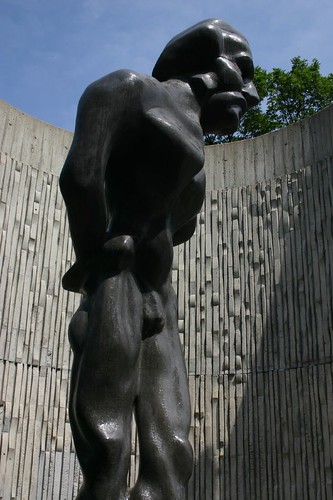
"[Louise Riel] portrayed as a man in bondage who sacrificed himself for his principles and his country." - written on a plaque at the foot of the statue which now stands on the grounds of St. Bonifice College.
"All that I have done and risked, and to which I have exposed myself, rested certainly on the conviction that I was called upon to do something for my country." - Loiuse Riel, July 31, 1885
Three and a half months after making the above statement to the court, Riel was hanged in Regina, Saskatchewan for treason. Though the actions of Riel and the Red River rebellion are more than a century in the past, Riel still is able to cause controversy. A stylized statue of him, gaunt with sunken cheeks and eyes, was installed on the grounds of the Manitoba Legislature in 1970 that raised many eyebrows. It was replaced in 1991 by a statue that was "more representative, one more in keeping with Louise Riel's role as a statesman."
This was my first visit to Winnipeg as an adult. I was there in the '70's when we made our cross-Canada trip as a family. I was seven-years-old at the time and my only recollection is standing outside a phone both - the parents would periodically call east to see that all was well and on this occasion we learned a tropical storm had ravaged Halifix, and I missed it, argh - engulfed in a cloud of mosquitoes. In fact, I think a pack of them tried to carry me off, prompting the parents to declare Winnipeg's downtown Hudson's Bay Co. store a significant cultural site worth visiting. We spent the day. I did pass through on my way to Vancouver in 1996, and yes I was an adult then, but it hardly counts as a visit. The train rolled in, stopped, gained some passengers, lost some passengers, and rolled out. All in a very neat, orderly, and timely process. My only real recollection of that brief stay was the announced temperature of -35c.
Considering both these past brushes with the city involved two of the more unfavourable, yet highly iconic traits of Winnipeg - some might even call them qualities - it's a wonder I didn't avoid the place all together. But family does have a strong pull and I was looking forward to seeing the community dad had chosen to call home.
Winnipeg is a fair sized city and in my short time there I saw only a sliver of it. And, as seemed only fitting, it was the iconic I was interested in, though even at that I missed the Manitoba Legislature, considered by many to be the finest legislative building in the country with its golden boy perched at the top of the cupola. So I made a journey to Portage and Main, that place of cold northern winds, which for my visit was a hot sunny day. From a distance I saw Winnipeg stadium, home of the Blue Bombers.

St. Boniface College, Winnipeg.
I also visited St. Bonifice College. Still operating only in french, the school in downtown Winnipeg is a testament to the significance of the french on early Manitoban development. Adjacent to it is St. Boniface Cathedral which was built in 1908, but burned almost to the ground in 1968. A new cathedral was built within and around the ruins of the old one.

"[Louise Riel] portrayed as a man in bondage who sacrificed himself for his principles and his country." - written on a plaque at the foot of the statue which now stands on the grounds of St. Bonifice College.
"All that I have done and risked, and to which I have exposed myself, rested certainly on the conviction that I was called upon to do something for my country." - Loiuse Riel, July 31, 1885
Three and a half months after making the above statement to the court, Riel was hanged in Regina, Saskatchewan for treason. Though the actions of Riel and the Red River rebellion are more than a century in the past, Riel still is able to cause controversy. A stylized statue of him, gaunt with sunken cheeks and eyes, was installed on the grounds of the Manitoba Legislature in 1970 that raised many eyebrows. It was replaced in 1991 by a statue that was "more representative, one more in keeping with Louise Riel's role as a statesman."
Saturday, May 26, 2007
Jon's testament
"As reported by the Globe and Mail, Cpl. Matthew J. McCully was killed by a roadside bomb in Afghanistan yesterday, rounding out the number of Canadian KIAs in that war to 55.
Rest in Peace bud, CFB Kingston was a hoot."
- jon braun
Friday, May 25, 2007
journey east: day 13
June 14, 2006
I drove 626 km today for a total of 2815 km travelled since leaving North Vancouver. High temperature was 26c.
The call of peacocks somewhere in the park, or is it the call of peahens? Either way it is a haunting sound. I'm at a campground nestled in a residential part of Souris, Manitoba. I wonder what the neighbors think of Victoria Park campground and its noisy peacock/peahens.
My tent is set up not too far from a stagnant brown river. The opposite campsite has two trailers. Its occupants, five adults, are headed tomorrow for a game of golf. It is a big annual deal for them and the spirits are flowing. In a tree notch nearby Mystic Forest incense burns. For now, scotch will do. I just noticed there is a golf cart in the back of the pickup across the way.
This place, set within trees set within an urban landscape, is far removed from the wide open space I occupied last night. No predators, no danger from the dark. This morning I left a place muddied, but unbloodied or bruised, which was flat, treeless, and mostly dry.
Both places have chilling midnight calls: peacocks and coyotes.
Last night at Grasslands National Park it was remarkable for the stars, the moon, the wail of the coyote and the dry winds of the prairie. This morning it was remarkable for the dark clouds which brought hail and rain and thunder and great pink and green streaks of lightning.
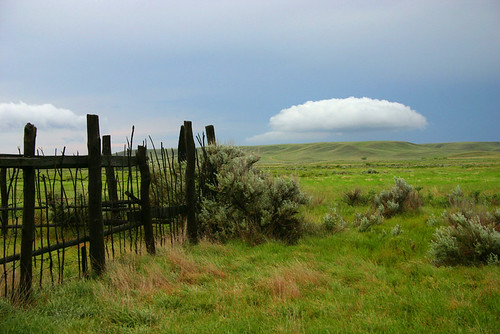
after the rain. Grasslands National Park.
I took few photos today. I was not in a sight seeing frame of mind. Distance on the prairies is deceiving, even with a map to guide, and I have a long way to travel. Winnipeg tomorrow.
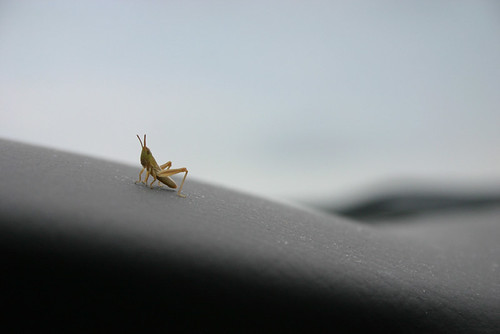
Found this little guy checking me out when I woke from my nap. I don't think he wanted to eat me.
For most of the day I travelled into a headwind. A bit of a hassle because it requires greater concentration to keep the car on the road. But the winds have a pleasant side to them as well. The grasses at the roadside are green and at times are mixed with the silver tips of barley. In the wind the shimmer like ocean waves. Organic, rippling, these are Saskatchewan seas.
Haiku (composed long ago)
Saskatchewan seas
An early summer wind blows
Green waves across fields
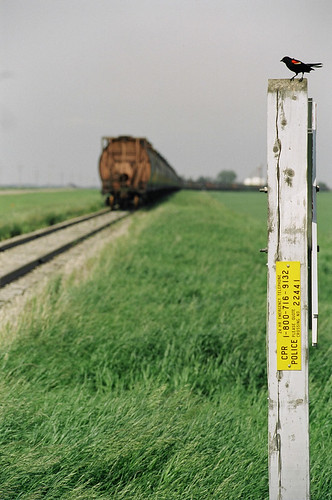
A bird on a post somewhere in Saskatchewan.
There are oil rigs all through southern Saskatchewan. They are clustered more frequently and in larger numbers than I ever sawin Alberta. Industrial metronomes pulling oil up and out of the earth they age like farming machinery, looking rusty and crusty as the years go on.
I drove 626 km today for a total of 2815 km travelled since leaving North Vancouver. High temperature was 26c.
The call of peacocks somewhere in the park, or is it the call of peahens? Either way it is a haunting sound. I'm at a campground nestled in a residential part of Souris, Manitoba. I wonder what the neighbors think of Victoria Park campground and its noisy peacock/peahens.
My tent is set up not too far from a stagnant brown river. The opposite campsite has two trailers. Its occupants, five adults, are headed tomorrow for a game of golf. It is a big annual deal for them and the spirits are flowing. In a tree notch nearby Mystic Forest incense burns. For now, scotch will do. I just noticed there is a golf cart in the back of the pickup across the way.
This place, set within trees set within an urban landscape, is far removed from the wide open space I occupied last night. No predators, no danger from the dark. This morning I left a place muddied, but unbloodied or bruised, which was flat, treeless, and mostly dry.
Both places have chilling midnight calls: peacocks and coyotes.
Last night at Grasslands National Park it was remarkable for the stars, the moon, the wail of the coyote and the dry winds of the prairie. This morning it was remarkable for the dark clouds which brought hail and rain and thunder and great pink and green streaks of lightning.

after the rain. Grasslands National Park.
I took few photos today. I was not in a sight seeing frame of mind. Distance on the prairies is deceiving, even with a map to guide, and I have a long way to travel. Winnipeg tomorrow.

Found this little guy checking me out when I woke from my nap. I don't think he wanted to eat me.
For most of the day I travelled into a headwind. A bit of a hassle because it requires greater concentration to keep the car on the road. But the winds have a pleasant side to them as well. The grasses at the roadside are green and at times are mixed with the silver tips of barley. In the wind the shimmer like ocean waves. Organic, rippling, these are Saskatchewan seas.
Haiku (composed long ago)
Saskatchewan seas
An early summer wind blows
Green waves across fields

A bird on a post somewhere in Saskatchewan.
There are oil rigs all through southern Saskatchewan. They are clustered more frequently and in larger numbers than I ever sawin Alberta. Industrial metronomes pulling oil up and out of the earth they age like farming machinery, looking rusty and crusty as the years go on.
Thursday, May 17, 2007
journey east: day 12 - part 2
From the Elkwater townsite I once again headed back into the park. Bison used to roam the hills that make up the park, but like those of the plains, the bison are now all gone. The park wasn't always public either. It used to be private land and when the park was created local ranchers were compensated with rights to graze their cattle in the hills. It makes for an interesting wilderness experience. Last night I could hear cows beyond the hill on the other side of the lake mooing into the darkness. This morning, on my way out of town, I came across a cowboy moving a herd along a road, and a little further along I came across another herd.
I wonder what it was like in the hills here 10,000 years ago. During the last ice age, when ice sheets half a kilometre thick covered the prairies, the Cypress Hills were spared. They were they only oasis of land between the Rockies and the Atlantic Ocean. I can't imagine.
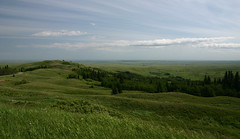
View from an island. The plains in the distance were covered in ice during the last ice age.
The trip through the park was nice. The weather was sunny and warm and there was no other traffic on the road, which wasn't surprising because it was a dirt road. Not gravel. Dirt. I learned later, the next day actually, that there is a profound difference between a gravel and dirt road. While travelling this dirt road I came across a mob, if that's the right word, of butterflies in the middle of the road lunching on a pile of shit. Ah, such vile beauty. I also came across a funny sign that posted both the speed limit, 40 kilometres and hour, and a warning that speed limits are enforced using photo-radar. Good luck getting a ticket on these roads.
Once I was on the Saskatchewan side I took a short detour to the Fort Walsh National Historic Site.
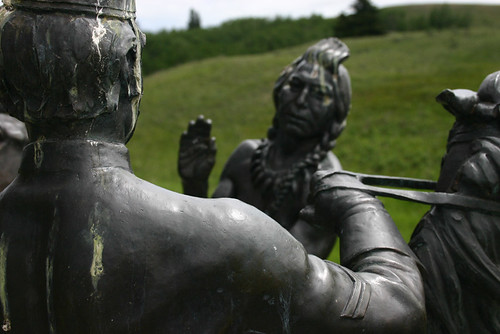
Fort Walsh was established by the North West Mounted Police in the late 1800's. It was built in response to the massacre of Nakoda people in 1873 by a group of angry white men on horses who rode up from Montana looking for horse thieves. Among other things, the fort aided Lakoda refugees led by Sitting Bull who were fleeing the Sioux wars of 1876-1877. A bronze statue at the information centre marks Sitting Bull's arrival at the fort.
I left the park and was momentarily filled with glee that I was once again driving on asphalt. It was a short lived glee. Every few hundred metres there were signs warning drivers about 'pavement breaks' which were accompanied by little red markers placed at road level right where the pavement was broken. The pavement was really broken. Reall, really broken. There were times I would drive 200 too 300 metres on the wrong side of the road to avoid broken pavement.
Now, of course this was not the Trans Canada Highway I was on. This was more a tertiary highway and I suppose in the grand scheme of things traffic levels don't justify the outlay of money for repairs. It was not just roads that were neglected. The rail line had been taken out too, and whole towns were disappearing.
I passed through Climax, where I had to go just to say I had been to Climax, with its cute though predictable sign on the way out of town that reads, 'Hope you enjoyed Climax, please come again,' and soon came to Orkney. About 40 km of highway 18 separates Climax and Orkney, and what a difference 40 km can make. Orkney is a town no longer. As a kid I used to think of ghost towns as a cowboy, old-west kind of thing. But they are a new-west kind of thing too. And at the root of the emptying of urban settlements like Orkney looms large a simple fact: the rail road goeth no longer.
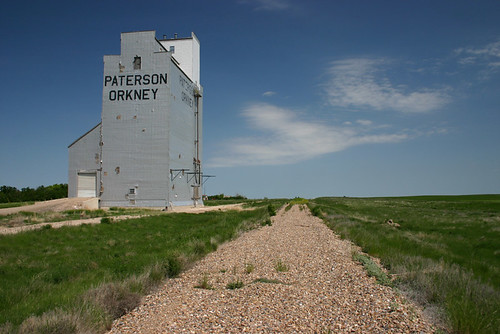
There is not much left in Orkney. Homes and businesses are abandoned, the school is empty, and what was once a commercial block is now evident only from the outline of its building's overgrown foundations. The population of white-tail deer was higher than that of humans.

There were still two homes in town that looked occupied, but I didn't have time to get nosy with the residents. While taking photos of a row of houses, I came around a corner and startled two white-tail deer, who promptly startled me. The whole town was eerily silent, save for the songs of birds and the whispering of a warm prairie wind. Periodically a car drove through town, east to west, west to east, didn't matter, the driver's eyes firmly planted on the road ahead. Sometimes it's rude to stare at wrecks at the side of the road.
I arrived at Grasslands National Park in the late afternoon, checked in at the park office, then headed into the vast open space of the park for the night. I didn't take many notes that night. I was a little overwhelmed by the scenery. Following is my last journal entry for the day.
I wonder what it was like in the hills here 10,000 years ago. During the last ice age, when ice sheets half a kilometre thick covered the prairies, the Cypress Hills were spared. They were they only oasis of land between the Rockies and the Atlantic Ocean. I can't imagine.

View from an island. The plains in the distance were covered in ice during the last ice age.
The trip through the park was nice. The weather was sunny and warm and there was no other traffic on the road, which wasn't surprising because it was a dirt road. Not gravel. Dirt. I learned later, the next day actually, that there is a profound difference between a gravel and dirt road. While travelling this dirt road I came across a mob, if that's the right word, of butterflies in the middle of the road lunching on a pile of shit. Ah, such vile beauty. I also came across a funny sign that posted both the speed limit, 40 kilometres and hour, and a warning that speed limits are enforced using photo-radar. Good luck getting a ticket on these roads.
Once I was on the Saskatchewan side I took a short detour to the Fort Walsh National Historic Site.

Fort Walsh was established by the North West Mounted Police in the late 1800's. It was built in response to the massacre of Nakoda people in 1873 by a group of angry white men on horses who rode up from Montana looking for horse thieves. Among other things, the fort aided Lakoda refugees led by Sitting Bull who were fleeing the Sioux wars of 1876-1877. A bronze statue at the information centre marks Sitting Bull's arrival at the fort.
I left the park and was momentarily filled with glee that I was once again driving on asphalt. It was a short lived glee. Every few hundred metres there were signs warning drivers about 'pavement breaks' which were accompanied by little red markers placed at road level right where the pavement was broken. The pavement was really broken. Reall, really broken. There were times I would drive 200 too 300 metres on the wrong side of the road to avoid broken pavement.
Now, of course this was not the Trans Canada Highway I was on. This was more a tertiary highway and I suppose in the grand scheme of things traffic levels don't justify the outlay of money for repairs. It was not just roads that were neglected. The rail line had been taken out too, and whole towns were disappearing.
I passed through Climax, where I had to go just to say I had been to Climax, with its cute though predictable sign on the way out of town that reads, 'Hope you enjoyed Climax, please come again,' and soon came to Orkney. About 40 km of highway 18 separates Climax and Orkney, and what a difference 40 km can make. Orkney is a town no longer. As a kid I used to think of ghost towns as a cowboy, old-west kind of thing. But they are a new-west kind of thing too. And at the root of the emptying of urban settlements like Orkney looms large a simple fact: the rail road goeth no longer.

There is not much left in Orkney. Homes and businesses are abandoned, the school is empty, and what was once a commercial block is now evident only from the outline of its building's overgrown foundations. The population of white-tail deer was higher than that of humans.

There were still two homes in town that looked occupied, but I didn't have time to get nosy with the residents. While taking photos of a row of houses, I came around a corner and startled two white-tail deer, who promptly startled me. The whole town was eerily silent, save for the songs of birds and the whispering of a warm prairie wind. Periodically a car drove through town, east to west, west to east, didn't matter, the driver's eyes firmly planted on the road ahead. Sometimes it's rude to stare at wrecks at the side of the road.
I arrived at Grasslands National Park in the late afternoon, checked in at the park office, then headed into the vast open space of the park for the night. I didn't take many notes that night. I was a little overwhelmed by the scenery. Following is my last journal entry for the day.
June 13, 2006
Stars in a prairie sky.
Eleven minutes remain on my first long exposure photo of the night. Sitting in the tent doorway, I realize I am happier than I have been for a very long time. Above me the biggest sky I have ever seen, full of stars, wonder and promise.
I can't imagine a better way to end the day than with a full moon rising.
Wednesday, May 16, 2007
journey east: day 12
Finally, day 12. It was starting to feel a little like the movie Groundhog Day around here. Although I have a feeling this will be another multi-entry day.
June 13, 2006
Last morning in Alberta.
I started early today. It's hard to sleep in the face of the rising sun. I slept fitfully last night [probably because of cougars checking me out] and woke early. After packing things up I went for a thirty minute hike. The sign at the trail-head called it The Lake Loop. Well that was a bit of a disappointment. It looped, but it didn't loop around the lake. Rather, it looped back up into the woods. Not terribly scenic, or exciting.
The best part of Spruce Coulee.
Back on the road and beyond the gravel I passed back across a plain I had crossed the previous day. This morning it was swarming with birds out looking for breakfast. There were two types of birds, both just a few inches from beak to tail and each remarkable in its own way. One type of bird was a deep sky-blue with silver trim. Dozens of them skimmed across the field, little blue streaks flying against blue sky, then dipping through green grass.
The other type of bird was rather unremarkable to look at. However they could hover in one spot for a short period, despite a rather strong wind blowing in from the east, then swiftly glide just above ground level, wingtips brushing the grass looking for food. I didn't even try to get photos of them.
Everything a vacationer could want was available at the Elkwater Grocery and Restaurant: junk food, beer, cigarettes, postcards, romance novels, firewood, and pancakes served with maple syrup [which I spilled in my journal.] This is where I had breakfast. The woman who served me said the town's population is 67. I find that number hard to believe, but she assures me that in the off-season that number dips to around 30.
For such a small town, the restaurant was pretty big. And I was the only person there. It is not until now, as I look back on it, that it kind of creeps me out. I remember it now as the kind of place where a car drives into town and vanishes. The wind was formidable, the streets were empty, and there was no one to be seen. Had a great visitor centre though.
Soon I was back on the road, heading east through the park, for Saskatchewan.
There are two animals that haven't done so well in encounters with the car. Richardson's ground squirrels and a particularly daring kind of swallow - at least I think they're swallows.
My killing spree started yesterday with the swallow-like bird: dark grey with white feathers in the tail - usually that's the only part of them I see. It is like they are playing a game of chicken with me. Call it sparrow instead. A group of sparrows hanging out on the pavement, presumably eating dead stuff, dare each other to see who will be the last to take off. Yesterday one zigged when it should have zagged and flew straight into the front wheel of the car. Man it was fast. The sparrow was doing ok too, just took a wrong turn.
This morning it was Richardson's Ground Squirrels, which a lot of people call gophers. What I noticed while travelling these last few days is that for some reason, these furry slim rodents measuring up to 30 centimetres long seem always to want to be on the side of the road they're not already on. Come upon one at over one-hundred kilometres an hour as it is making its first tentative strides across hot asphalt and it will promptly do a 180 degree turn and do a wheelie as it accelerates back to the shadows of grass growing at the side of the road. Sometimes I come across them lazing about in the middle of the road. They aren't always successful in keeping out of danger. Today I hit two of them. Just like that the life is crushed out of them by a tonne of rubber.
not a herd of Richardson's ground squirrels.
On one occasion I came across two Richardson's in my lane. One safely skedaddled to the nearest side of the road. The other one made a lunge for the other lane, stopped, then started again before making one of those wheelie moves straight at the car. If I hadn't seen it happen I may not have noticed the slight bump. Further down the road I hit another one, connected hard with the ass of a not swift enough swallow, and then just barely missed another Richardson's that, when I last saw it in my rear-view mirror, was standing frozen and erect right on the centre line of the road.
Tuesday, May 15, 2007
journey east: day 11 - an epilogue of sorts
June 12, 2006
The prairies are flat, with lots of horizon, and really big sky. That is sort of what prairies are all about. So the Cypress Hills, which rise 600 metres up out of the prairies, should really stand out. But they don't. In fact, they seem to appear out of the flatness rather abruptly, like some optical illusion or local practical joke meant to freak out tourists.
Spanning the Alberta/Saskatchewan border the Cypress Hills Interprovincial Park was one of the areas I originally planned on hanging around for a while. I wanted to explore the area, meet the people, see the sights, smell the air, breath it all in, and hopefully have a lasting enough experience I could write about. But Writing-on-Stone was an unexpected and overwhelmingly delightful experience that, when combined with a visit to the Etzikom Museum, sort of sucked the day's ration of exploration energy out of me - and a good chunk of time. So, by the time I reached the Cypress Hills area it was later in the day than I had expected.
Like Banff, Jasper, and any number of other parks, Cypress Hills has a town within its boundaries: Elkwater. According to the map of the park I picked up back in Milk River it didn't look too far between Elkwater and the campground I was heading for, so I decided I would head back to town once I got myself settled. I drove on and up along a winding road into a thickening pine forest. This was the most trees I had seen in days.
Maps serve as guides, thumbnail sketches of an area at 1:150,000 scale, but often do little to alert the reader to what he will really find on his journey other than generalities. What does it mean if a road is unpaved? Is it dirt? Gravel? Soybean? Maps tend to offer few clues. Scale can be deceiving as well. Thus I found myself, with the sun hurtling toward the horizon, riding along a gravel road up over hills and down through hollows on a short journey, by the map's scale, to the Spruce Coulee campground.

I'm not sure where this map came from, but I'm pretty sure I didn't rely on it to get me anywhere.
For a seemingly short journey it seemed to take forever to get to the end of the road, and I have to say I was a little disappointed when I finally arrived at the campground. It looked like one of those places people go for long-weekend parties. It was a tough looking, hooligan attracting, campground with evidence of campfires held in non-designated campfire areas, faded beer cans scattered in the bushes, and the campsites themselves looked a little shabby.
But it wasn't a long-weekend and I was only staying one night. And I had the whole place to myself.
As I hauled my gear from the parking area to the campsite I had chosen a pick-up truck arrived. Great, I thought to myself, here come the hooligans. But it was only a park ranger who seemed a little lonely and kind of surprised to see me. We had a conversation I sort of wish we hadn't had.
John: Hi.
Ranger: Howdy
J: Nice evening, eh?
R: Yup. Hope you don't mind the flies.
J: Flies are okay. I don't imagine there are any bear in these parts are there?
R: Nope. Killed the last one 'bout a hundred years ago.
J: Hmmm. That's too bad.
R: Yup, 1905 I think it was.
J: Well, at least I don't have to worry about them. I've been camping in the mountains for a week. Hungry bears sort of have an effect on you.
R: Nope. Don't have to worry bout them here.
pause ...
R: Now Cougars on the other hand.
pause ...
J: Cougars?
R: Yup. There was a fresh kill just a week ago down near the town.
J: Fresh kill?
R: Yup. Deer.
J: phew.
R: Well, gotta go.
J: Er, right, thanks for the chat.
Ranger hops in his truck and is just about to drive away when ...
J: Hey, can you come here for a moment?
R: Yup.
J: (pointing to paw print in mud) What's that?
R: Probably a dog.
J: You sure?
R: Pretty sure.
J: K. Thanks.
Silent death lurking in the forest. Statistically speaking I knew the odds of being tender vittles for a 150 kilogram cat were greater than being struck by lightning, but ... I built a good fire and kept it stoked until the scotch had made me brave and the pot had made me mellow. I never did make it back to Elkwater that night.
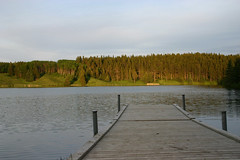
The best thing about Spruce Coulee at Cypress Hills Interprovincial Park.
The prairies are flat, with lots of horizon, and really big sky. That is sort of what prairies are all about. So the Cypress Hills, which rise 600 metres up out of the prairies, should really stand out. But they don't. In fact, they seem to appear out of the flatness rather abruptly, like some optical illusion or local practical joke meant to freak out tourists.
Spanning the Alberta/Saskatchewan border the Cypress Hills Interprovincial Park was one of the areas I originally planned on hanging around for a while. I wanted to explore the area, meet the people, see the sights, smell the air, breath it all in, and hopefully have a lasting enough experience I could write about. But Writing-on-Stone was an unexpected and overwhelmingly delightful experience that, when combined with a visit to the Etzikom Museum, sort of sucked the day's ration of exploration energy out of me - and a good chunk of time. So, by the time I reached the Cypress Hills area it was later in the day than I had expected.
Like Banff, Jasper, and any number of other parks, Cypress Hills has a town within its boundaries: Elkwater. According to the map of the park I picked up back in Milk River it didn't look too far between Elkwater and the campground I was heading for, so I decided I would head back to town once I got myself settled. I drove on and up along a winding road into a thickening pine forest. This was the most trees I had seen in days.
Maps serve as guides, thumbnail sketches of an area at 1:150,000 scale, but often do little to alert the reader to what he will really find on his journey other than generalities. What does it mean if a road is unpaved? Is it dirt? Gravel? Soybean? Maps tend to offer few clues. Scale can be deceiving as well. Thus I found myself, with the sun hurtling toward the horizon, riding along a gravel road up over hills and down through hollows on a short journey, by the map's scale, to the Spruce Coulee campground.

I'm not sure where this map came from, but I'm pretty sure I didn't rely on it to get me anywhere.
For a seemingly short journey it seemed to take forever to get to the end of the road, and I have to say I was a little disappointed when I finally arrived at the campground. It looked like one of those places people go for long-weekend parties. It was a tough looking, hooligan attracting, campground with evidence of campfires held in non-designated campfire areas, faded beer cans scattered in the bushes, and the campsites themselves looked a little shabby.
But it wasn't a long-weekend and I was only staying one night. And I had the whole place to myself.
As I hauled my gear from the parking area to the campsite I had chosen a pick-up truck arrived. Great, I thought to myself, here come the hooligans. But it was only a park ranger who seemed a little lonely and kind of surprised to see me. We had a conversation I sort of wish we hadn't had.
John: Hi.
Ranger: Howdy
J: Nice evening, eh?
R: Yup. Hope you don't mind the flies.
J: Flies are okay. I don't imagine there are any bear in these parts are there?
R: Nope. Killed the last one 'bout a hundred years ago.
J: Hmmm. That's too bad.
R: Yup, 1905 I think it was.
J: Well, at least I don't have to worry about them. I've been camping in the mountains for a week. Hungry bears sort of have an effect on you.
R: Nope. Don't have to worry bout them here.
pause ...
R: Now Cougars on the other hand.
pause ...
J: Cougars?
R: Yup. There was a fresh kill just a week ago down near the town.
J: Fresh kill?
R: Yup. Deer.
J: phew.
R: Well, gotta go.
J: Er, right, thanks for the chat.
Ranger hops in his truck and is just about to drive away when ...
J: Hey, can you come here for a moment?
R: Yup.
J: (pointing to paw print in mud) What's that?
R: Probably a dog.
J: You sure?
R: Pretty sure.
J: K. Thanks.
Silent death lurking in the forest. Statistically speaking I knew the odds of being tender vittles for a 150 kilogram cat were greater than being struck by lightning, but ... I built a good fire and kept it stoked until the scotch had made me brave and the pot had made me mellow. I never did make it back to Elkwater that night.

The best thing about Spruce Coulee at Cypress Hills Interprovincial Park.
Monday, May 07, 2007
on vacation
Taking a badly needed road trip this week. The adventures of my journey east will return next week.
Friday, May 04, 2007
journey east: day 11 - part three
The rural landscape is changing in the area. Not as many farms are operating as there were just a couple of decades ago and the population is moving to larger centres. Some of the farms, held by families for generations, are being swallowed up by large factory farms, and others are just being abandoned. During my travels it wasn't unusual to come across a homestead, of barns and a farmhouse, overrun by the elements.
On the highway to Foremost I came across one of these farms. An abandoned truck parked between a rundown barn and farmhouse set in a field of grass long since mowed or maintained. Beyond, a field looked ready for sowing, but not by any hands that might have worked the land in the past.
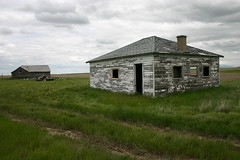
These buildings had a wonderfully weathered look to them. Had I not made the u-turn to go back and take photos I likely still would be kicking myself.
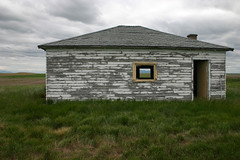
I don't know what function this building once served, but it could have been a small farmhouse. There is something about walking around places like this. I'm not a superstitious person, but it's hard not to think you're rubbing shoulders with ghosts.
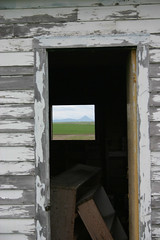
The Sweetwater Hills are framed in the window.
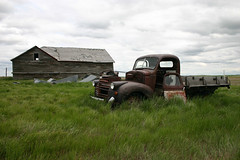
Who knows when it happened, but one day in the past someone parked this truck and never returned to it. Ever. It always strikes me as peculiar to see vehicles abandoned in people's yards.
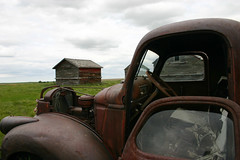
Inside and out the truck showed its age. Something tells me I could return to this spot in a dozen years and not much will have changed.
William was a good man to point me toward the Museum in Etzikom. He had not visited it himself, but was emphatic that he had heard only good things about it. People who know a thing or two about museums, he said, had told him it was a standout place. How could I resist?
When I parked the car it was the only one in the lot. The first thing to capture my attention was the field of windmills behind the old '50's style, single story, former school that housed the museum. The loose collection of windmills marks the grandly titled Canadian National Historic Windpower Centre. Not to minimize the historical significance of the pieces here, it resembled a rather large mini-golf course, asphalt trails and all. The windmills, with the exception of the largest one, were representative of what would have been used on the prairies over the last century. The largest one looked more like a Dutch style windmill and was shipped to the museum in pieces from Martha's Vineyard.

Canadian National Historic Windpower Centre
Etzikom has a population of about 60 and the re-purposing of the school is again a reflection of the migration of people away from rural areas. There just aren't enough young people in the area to justify the community having its own school. The lobby of the building is now the museum's cafe. It's styled a little after an old country diner, with a bar and stools and where you can get a shake or piece of fresh-baked pie. It was starting to feel a little hokey, and I wasn't sure if I'd pay the $4 entry fee to get a gander at the whole thing. But, the woman who was working the museum spoke so enthusiastically about what lay just beyond the cash-jar, where entry fees went, I parted with $5 and headed right in. What a treat.
Each of the school's classrooms was assigned a theme, and dioramas were built to reflect what life might have looked like for the average homesteaders in the early part of the 1900's. There was a streetscape with a general store, a hotel, post office and carriage. I'm not an expert on the period being depicted, but I was impressed with the details.
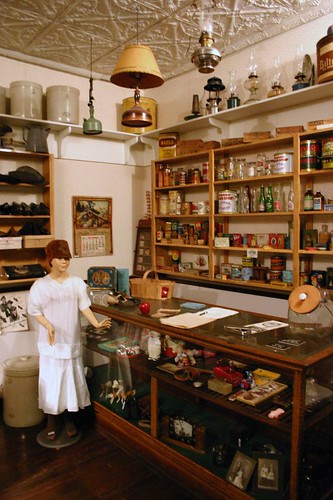
Inside the General Store.
I spent an hour wandering from room to room, taking it all in. There was a clothing room, with clothes and toys from the period, and a music room filled with pianos, player pianos and artifacts from music playing of yore, including paper rolls for the player pianos, 72 and 33 rpm records, and music books for entertaining the family. The wildlife and Natural History room was a bit creepy, but that's only because I find large collections of dusty, old, dead stuffed animals just not totally right. Some of the taxidermy left something to be desired.
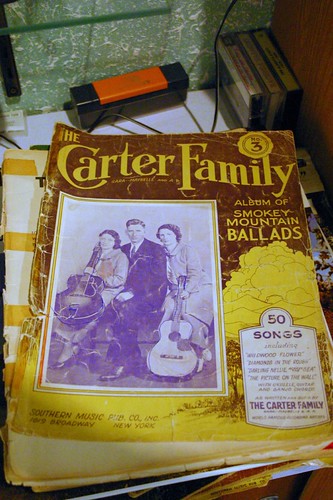
Yay, the Carter Family Album of Smokey Mountain Ballads.
The Homesteader room was the most fascinating room in the museum. A kitchen, parlour and bedroom all stocked in the quaint manner typical of the period. The detail was quite remarkable and it left me feeling pretty good about many of the modern conveniences available to me. Now that I think about it, the picture isn't complete without a detailed diorama of where homesteaders went to, ahem, relieve themselves. No doubt nothing quaint about that.

Would they really have had a portrait of the Queen on the wall?
Raylene, the woman who had coaxed me into the museum, was always at hand, ready with answers to my questions. I wasn't trying to stump her or anything, but in hindsight I wish I had, because her knowledge of the museum and the area seemed complete. She was like the knowledge god of Etzikom.
She also coaxed a piece of fresh apple pie down my throat. The pie was delicious and I challenge anyone to find a place that serves even mass produced pie for $2.50 a slice. yummy. Raylene said some money for running the museum comes from the provincial and federal governments, but that a lot of the money has come from donations. The wall behind the museum cafe's counter is filled with plaques noting donations made by locals, many of whom are descendants of homesteaders. In those cases the date and location of the homestead is included on the plaque.

Every issue of National Geographic dated between 1924 and 1996 is on the shelf of the Etzikom Museum library. To everyone who passes through, Raylene, one of the museum's staff, suggests they take a look at the copy dated the month of their birth.
After my long and unanticipated visit to the Etzikom Museum I realized every little town has a story to tell. Etzikom's story is that of the settling of the prairies and of the homesteaders. It preserves a glimpse at a way of life hard to imagine 100 years later. There will be other tales, in other towns, and I have to remember to take the time to listen and observe those tales when the cross my path.
On the highway to Foremost I came across one of these farms. An abandoned truck parked between a rundown barn and farmhouse set in a field of grass long since mowed or maintained. Beyond, a field looked ready for sowing, but not by any hands that might have worked the land in the past.

These buildings had a wonderfully weathered look to them. Had I not made the u-turn to go back and take photos I likely still would be kicking myself.

I don't know what function this building once served, but it could have been a small farmhouse. There is something about walking around places like this. I'm not a superstitious person, but it's hard not to think you're rubbing shoulders with ghosts.

The Sweetwater Hills are framed in the window.

Who knows when it happened, but one day in the past someone parked this truck and never returned to it. Ever. It always strikes me as peculiar to see vehicles abandoned in people's yards.

Inside and out the truck showed its age. Something tells me I could return to this spot in a dozen years and not much will have changed.
June 12, 2006
Etzikom and the Etzikom Museum was my next stop. Back at the tourist info centre in Milk River, William suggested I pay a visit to the museum. He had heard good things about it. I wasn't disappointed. I won't get into too many details because it's getting late.
The museum is actually two museums in one. The first thing you notice when you arrive is the field of windmills. Dozens of different styles, including one that was shipped in from Martha's Vineyard. The building itself is a converted school. Inside, the classrooms were each given a theme that reflected an aspect of homesteader life in the area. The museum was about the homesteaders and was supported by descendants of homesteaders. It was an unexpected surprise and a real delight.
William was a good man to point me toward the Museum in Etzikom. He had not visited it himself, but was emphatic that he had heard only good things about it. People who know a thing or two about museums, he said, had told him it was a standout place. How could I resist?
When I parked the car it was the only one in the lot. The first thing to capture my attention was the field of windmills behind the old '50's style, single story, former school that housed the museum. The loose collection of windmills marks the grandly titled Canadian National Historic Windpower Centre. Not to minimize the historical significance of the pieces here, it resembled a rather large mini-golf course, asphalt trails and all. The windmills, with the exception of the largest one, were representative of what would have been used on the prairies over the last century. The largest one looked more like a Dutch style windmill and was shipped to the museum in pieces from Martha's Vineyard.

Canadian National Historic Windpower Centre
Etzikom has a population of about 60 and the re-purposing of the school is again a reflection of the migration of people away from rural areas. There just aren't enough young people in the area to justify the community having its own school. The lobby of the building is now the museum's cafe. It's styled a little after an old country diner, with a bar and stools and where you can get a shake or piece of fresh-baked pie. It was starting to feel a little hokey, and I wasn't sure if I'd pay the $4 entry fee to get a gander at the whole thing. But, the woman who was working the museum spoke so enthusiastically about what lay just beyond the cash-jar, where entry fees went, I parted with $5 and headed right in. What a treat.
Each of the school's classrooms was assigned a theme, and dioramas were built to reflect what life might have looked like for the average homesteaders in the early part of the 1900's. There was a streetscape with a general store, a hotel, post office and carriage. I'm not an expert on the period being depicted, but I was impressed with the details.

Inside the General Store.
I spent an hour wandering from room to room, taking it all in. There was a clothing room, with clothes and toys from the period, and a music room filled with pianos, player pianos and artifacts from music playing of yore, including paper rolls for the player pianos, 72 and 33 rpm records, and music books for entertaining the family. The wildlife and Natural History room was a bit creepy, but that's only because I find large collections of dusty, old, dead stuffed animals just not totally right. Some of the taxidermy left something to be desired.

Yay, the Carter Family Album of Smokey Mountain Ballads.
The Homesteader room was the most fascinating room in the museum. A kitchen, parlour and bedroom all stocked in the quaint manner typical of the period. The detail was quite remarkable and it left me feeling pretty good about many of the modern conveniences available to me. Now that I think about it, the picture isn't complete without a detailed diorama of where homesteaders went to, ahem, relieve themselves. No doubt nothing quaint about that.

Would they really have had a portrait of the Queen on the wall?
Raylene, the woman who had coaxed me into the museum, was always at hand, ready with answers to my questions. I wasn't trying to stump her or anything, but in hindsight I wish I had, because her knowledge of the museum and the area seemed complete. She was like the knowledge god of Etzikom.
She also coaxed a piece of fresh apple pie down my throat. The pie was delicious and I challenge anyone to find a place that serves even mass produced pie for $2.50 a slice. yummy. Raylene said some money for running the museum comes from the provincial and federal governments, but that a lot of the money has come from donations. The wall behind the museum cafe's counter is filled with plaques noting donations made by locals, many of whom are descendants of homesteaders. In those cases the date and location of the homestead is included on the plaque.

Every issue of National Geographic dated between 1924 and 1996 is on the shelf of the Etzikom Museum library. To everyone who passes through, Raylene, one of the museum's staff, suggests they take a look at the copy dated the month of their birth.
After my long and unanticipated visit to the Etzikom Museum I realized every little town has a story to tell. Etzikom's story is that of the settling of the prairies and of the homesteaders. It preserves a glimpse at a way of life hard to imagine 100 years later. There will be other tales, in other towns, and I have to remember to take the time to listen and observe those tales when the cross my path.
Thursday, May 03, 2007
journey east: day 11 - part two
The second of three parts. This was a really full day for me. It was my intention to visit a few specific areas along the way and immerse myself in them with the aim of later writing travel pieces on them. Southeastern Alberta was one of my focuses. However, my notes have since been misplaced and the prospect of writing about them, beyond these pages, is vastly diminished.
By the time I finished my day, at Cypress Hills Interprovincial Park, I was pretty done in and the prospect of touring the area for fact-finding just wasn't doing it for me. It also didn't help that though the weather was fine - sunny and hot - I was still early in the tourist season. Most places I visited, not just in Alberta but on my entire journey, were pretty empty of activity.
I have made the point before that I was travelling just weeks before kids were let out of school bringing on the full onset of the tourist season. I was at the shoulder of the shoulder season. My timing presented problems and opportunities. One of the problems was the lack of information at many of the sites I visited. At Writing-on-Stone there was only one person available to talk to and she wasn't on site. I had to travel to an administration area of the park, after I'd finished wandering the park, to meet and speak with her. And of course I wouldn't get a tour of the restricted area because it wasn't open yet.
On the other hand, I pretty much had the park to myself. When I arrived there was a school group wandering one area of the park. But within an hour all the 'tweens piled on their tour bus and were gone. The parking lot was mostly empty and the only sounds were made by animals and the wind.
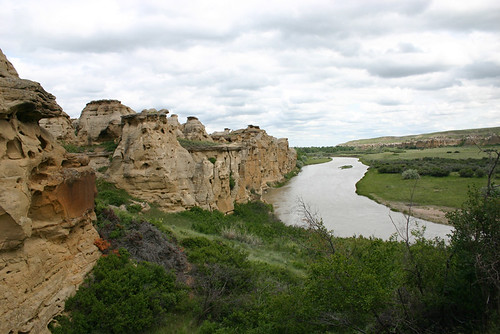
The Milk Rivers runs through Writing-on-Stone Provincial Park.
As I walked the park I understood why the Blackfoot held the area with such reverence. Aisinai pi - where the drawings are - has been visited by the Blackfoot for thousands of years. It's a holy place. Walking through the silent corridors created by hoodoos and coulees I felt those thousands of years of lore, magic, and history, crawl up my spine with a tingle. It's a sense of context I don't think I could have experienced had I not been alone in my visit.
By the time I finished my day, at Cypress Hills Interprovincial Park, I was pretty done in and the prospect of touring the area for fact-finding just wasn't doing it for me. It also didn't help that though the weather was fine - sunny and hot - I was still early in the tourist season. Most places I visited, not just in Alberta but on my entire journey, were pretty empty of activity.
June 12, 2006
Writing-on-Stone Provincial Park lies in the Milk River Valley and appears almost out of nowhere on Alberta's southern plains. Driving across the prairies through flat fields of farmland and sagebrush and suddenly the road dropped down over a ridge and into what looked like the largest termite colony in the world.
Hoodoos at Writing-on-Stone Provincial Park.
Hoodoos. A collection of striated pillars of sandstone worn away by meltwater 15 millennia ago when the glaciers last retreated from the area. The hoodoos run for miles following the valley of the Milk River. The park gets its name from pictographs depicting moments and events of the Blackfoot indians. The pictographs are painted images, but there are also images called petroglyphs carved into the soft stone. The images are crude and some are more than 1,000 years old. The Battle Scene is the most elaborate of the petroglyphs, covers a couple square metres of stone and has more than 130 figures in it.
It's a remarkable, magical place to explore. The Blackfoot refer to it as a living outdoor cathedral. Writing-on-Stone is a priceless part of the area's heritage. The tragic irony, and perhaps most frustrating element of the park, is the level of vandalism by those who get some joy from carving their initials or names into the stone. A shining example of this is at the Battle Scene. The dominant carved feature isn't the Battle Scene itself, but someone's initials carved deep and bold just inches above it. To protect it from further damage there is now an unsightly steel-mesh grating surrounding the scene. Aaargh, grating indeed. Posted throughout the park are signs warning against defacing the stone - $50,000 penalty - but, something tells me there have been few convictions.
Also in the park, but in a restricted zone on the other side of the Milk River, is an old North West Mounted Police outpost. This early in the season the park wasn't yet offering tours of the area. However, being early in the season also meant fewer people. In fact, almost no people.
I went for a hike along the Hoodoo Trail. It wanders through hoodoos for close to a kilometre, then dips down to river level where it takes a meandering trip through dense brush on the river's flood plain. The trail then heads back to higher ground, ending at the Battle Scene. Turkey vultures, swallows, magpies(lots of magpies,) pelicans and deer call the area home. The air is alive with birdsong.
I have made the point before that I was travelling just weeks before kids were let out of school bringing on the full onset of the tourist season. I was at the shoulder of the shoulder season. My timing presented problems and opportunities. One of the problems was the lack of information at many of the sites I visited. At Writing-on-Stone there was only one person available to talk to and she wasn't on site. I had to travel to an administration area of the park, after I'd finished wandering the park, to meet and speak with her. And of course I wouldn't get a tour of the restricted area because it wasn't open yet.
On the other hand, I pretty much had the park to myself. When I arrived there was a school group wandering one area of the park. But within an hour all the 'tweens piled on their tour bus and were gone. The parking lot was mostly empty and the only sounds were made by animals and the wind.

The Milk Rivers runs through Writing-on-Stone Provincial Park.
As I walked the park I understood why the Blackfoot held the area with such reverence. Aisinai pi - where the drawings are - has been visited by the Blackfoot for thousands of years. It's a holy place. Walking through the silent corridors created by hoodoos and coulees I felt those thousands of years of lore, magic, and history, crawl up my spine with a tingle. It's a sense of context I don't think I could have experienced had I not been alone in my visit.
From Writing-on-Stone I turned north toward foremost. Foremost is not much of a town in terms of size. One section of road with commercial and government operations on both sides, and the ubiquitous small-town manner of parking on a slant. I parked in front of The Liquor Cabinet, which was closed, as in no longer in operation, and popped into The Liquor Store which was right next door. I bet that was a good drag-em down fight for market dominance. The store was spacious with booze spread thinly along metal shelves. The prices were high, so I left.Tomorrow, Etzikom and photos from the roadside.
I went a couple of doors down to a 'cafe' where I bought the most expensive cup of coffee of my life: $3.00. Now this wasn't some yuppie coffee brewed from beans predigested by apes and slowly roasted for 50 years to the exacting standards of the Juan Valdez credo. This was coffee brewed in Foremost and served by a girl who based her pricing on an estimation of how much coffee my portable mug held. I'm happy to report the coffee didn't suck, it was in fact quite nice and far exceeded my expectations. But, it was not a $3.00 cup of coffee.
Wednesday, May 02, 2007
journey east: day 11 - part one
There was something special about this day. It was my first foray into the truly unfamiliar. The summer before I had been to Lethbridge with Meaghan and we had explored much of the surrounding area. Everything to this point on my trip, the mountains, B.C.'s interior, Southwestern Alberta, was familiar. Everything from this day forward, until my arrival in Fredericton, would be new to me. I didn't know what to expect and I was excited.
Some of my journal entries were pretty long. I packed a lot into this day and when I reached the campsite at Cypress Hills Interprovincial Park I filled many pages with my thoughts. Because of this I'm going to break the day into three parts.
Some of my journal entries were pretty long. I packed a lot into this day and when I reached the campsite at Cypress Hills Interprovincial Park I filled many pages with my thoughts. Because of this I'm going to break the day into three parts.
June 12, 2006Ah, to be blessed with a landscape like Alberta's. That is if you are in the business of building and maintaining a highway system. The best highways on my entire trip were in Alberta. Many are divided highways with wide shoulders that run straight for as far as the eye can see. The flatness of the prairie makes it hard to judge scale. A problem not limited just to distance, but also to speed. On more than one occasion I looked down and saw the needle on the speedometer creeping into the 150 kilometre an hour zone, and beyond. Even the gravel roads were better maintained and easier to drive than some of the secondary roads in other provinces - Saskatchewan had scary roads.
travelled 424km today/1758km total.
I left Lethbridge around 10a.m., heading south-east toward Milk River. About 30 minutes outside Lethbridge, just north of Warner, I came over a rise and far to the south, blue in the haze, I saw a mountain. I thought it might be my first glimpse of the Cypress Hills, but the direction was wrong and it seemed to soon in my trip. It was a remarkable sight to see: this lump thrusting up out of the flat prairies and into the clouds, with a central peak shaped like a ziggurat
The Sweetgrass Hills of Montana.
Twenty minutes later I was in Milk River where I learned I had been driving toward the Sweetgrass Hills in Montana. The Blackfoot name is Sweetgrass Mountains but apparently something got lost in translation. No biggy. Still later, when I was at Writing on Stone Provincial Park(which I'll get to in a moment,) I was told there actually very little sweetgrass in the area.
Milk River is just a few kilometres north of the border with the United States. I stopped in at the information centre where I spoke with William. In his 20's, William was from the area. His grandfather was a homesteader who moved to the area from Minnesota during the early 1900's. He said many of the early homesteaders were from around Minnesota as well as from Utah. The mormon population of the region is sizeable.
William has a farm a little ways away where he grows durham wheat. Durham is the dominant crop grown in the area, along with some mustard and a spattering of canola. He said there was a lot of canola grown until about 15 years ago, when Monsanto moved in. "A lot of farmers lost their shirts," he said and it just isn't grown anymore.
The mouse and gopher population seems healthy. There are an awful lot of hawks dining near the highway. Yesterday I watched one swoop down to the median, brake hard, then flap like mad back into the sky with a furry little critter twitching in its talons. Swift death from the sky.
At Milk River I turned east. It was here, along route 501, that I saw a badger scuttle across the highway. I learned later that badgers are nocturnal animals and a daylight sighting was rare. I'm just glad I didn't hit it. Low, sleek and built with a neck like a pitbull it hugged the highway as it crossed just metres in front of the car. I'm not sure what damage it would have done had we met tire to fur.
Tuesday, May 01, 2007
journey east: day 10
And yet another day, June 11, comes and goes without a journal entry. I just took a quick scan ahead in my little black notebook and see a pattern. When I was alone on my journey east I wrote in my journal. When I was with company, either family or friend, I didn't write.
So, once again the best of my recollection of the day.
What can you say about Lethbridge? I stayed with my sister Heather and her partner Barry. My visit came just around one year after they had moved there from Vancouver. It felt good to arrive and they had four seasons of experiences in a new land to share with me.
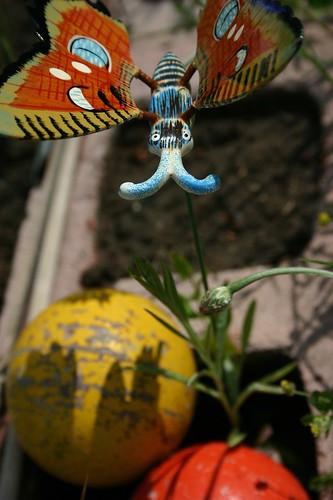
a critter in Heather and Barry's garden.
Heather and Barry are one of the few couples I know who walk the talk about minimizing their ecological footprint. Barry had been busy setting up a water reclamation system to capture runoff from the roof and there were 20 litre buckets all around the yard, some contained water, some didn't. A large barrel of water sat next to the house. The reclaimed water was destined for the garden. Laundry hung on a line that criss-crossed the yard and the garden was already being worked.
You can never have enough clothes lines. When I see one I'm taken back to my childhood, a simpler time, and I think they symbolize a way of life that is far less rushed than the ones many are living today. I wonder if anyone has ever studied a link between the prevalence of clothes lines and quality or pace of life. Do we live better when our clothes come in fresh and fluffy from the backyard?
There were a few errands I wanted to take care of and some sights I wanted to see while I was in town. Barry was off in the morning to work and after a nice homemade breakfast I was off to see a bit of Lethbridge. Heather seems quite taken by the city and I can understand why. It doesn't seem to have outgrown itself. Somehow, with growth, it has maintained a sense of what it is that gives it character. The city has a downtown area stereotypical of cities in the area. Wide avenues with slant parking and building that rarely climb much higher than four or five stories. It sprawl, but not in a suburban way, more like in a cowboy hanging out on hay bales kind of way: relaxed and casual, but purposeful.
Lethbridge is cut in two by the Oldman River. The river valley cuts 100 metres down through the flat prairie landscape on which the city of 80,000 is built. Two notable architectural features of Lethbridge involve the valley. First, the University of Lethbridge is located on the west side of the valley. University Hall looks like a recent addition to the campus and it is this building that is most striking. It looks as though it has slipped down into the valley. The long structure cuts through the ridges of coulees lining the steep valley walls and flows down into their troughs. It's a most unobtrusive and organic design, and looks like the valley has grown around it.
The second architectural feature spans the valley from east to west and is the polar opposite from the University of Lethbridge campus in that only a blind person could miss it, and even then I'm not so sure. The High Level Bridge was built by the Canadian Pacific Railway in 1909. It stands 100 metres above the lowest part of the Valley and stretches more than 1.5 kilometres from end to end. It is the longest and highest bridge of its kind in the world and is truly spectacular to look at. I get shivers just thinking about crossing it on foot.

The High Level bridge in Lethbridge is the highest and longest bridge of its kind in the world.
Beyond my sightseeing I had a few necessities to pick up. I found a game shop that sold large dice. I picked one up for myself to replace that which was stolen by the felonious raven in Yoho, and a dozen and a half for mom (she has a dice fetish.) I bought a $2 pair of sequined flip-flops for footsie protection in alien public showers. And I bought a $20 phone card that gave me a remarkable amount of minutes of long distance chatting so I could keep in comfortable contact with my honey.
And no, my mom doesn't really have a dice fetish.
So, once again the best of my recollection of the day.
What can you say about Lethbridge? I stayed with my sister Heather and her partner Barry. My visit came just around one year after they had moved there from Vancouver. It felt good to arrive and they had four seasons of experiences in a new land to share with me.

a critter in Heather and Barry's garden.
Heather and Barry are one of the few couples I know who walk the talk about minimizing their ecological footprint. Barry had been busy setting up a water reclamation system to capture runoff from the roof and there were 20 litre buckets all around the yard, some contained water, some didn't. A large barrel of water sat next to the house. The reclaimed water was destined for the garden. Laundry hung on a line that criss-crossed the yard and the garden was already being worked.
You can never have enough clothes lines. When I see one I'm taken back to my childhood, a simpler time, and I think they symbolize a way of life that is far less rushed than the ones many are living today. I wonder if anyone has ever studied a link between the prevalence of clothes lines and quality or pace of life. Do we live better when our clothes come in fresh and fluffy from the backyard?
There were a few errands I wanted to take care of and some sights I wanted to see while I was in town. Barry was off in the morning to work and after a nice homemade breakfast I was off to see a bit of Lethbridge. Heather seems quite taken by the city and I can understand why. It doesn't seem to have outgrown itself. Somehow, with growth, it has maintained a sense of what it is that gives it character. The city has a downtown area stereotypical of cities in the area. Wide avenues with slant parking and building that rarely climb much higher than four or five stories. It sprawl, but not in a suburban way, more like in a cowboy hanging out on hay bales kind of way: relaxed and casual, but purposeful.
Lethbridge is cut in two by the Oldman River. The river valley cuts 100 metres down through the flat prairie landscape on which the city of 80,000 is built. Two notable architectural features of Lethbridge involve the valley. First, the University of Lethbridge is located on the west side of the valley. University Hall looks like a recent addition to the campus and it is this building that is most striking. It looks as though it has slipped down into the valley. The long structure cuts through the ridges of coulees lining the steep valley walls and flows down into their troughs. It's a most unobtrusive and organic design, and looks like the valley has grown around it.
The second architectural feature spans the valley from east to west and is the polar opposite from the University of Lethbridge campus in that only a blind person could miss it, and even then I'm not so sure. The High Level Bridge was built by the Canadian Pacific Railway in 1909. It stands 100 metres above the lowest part of the Valley and stretches more than 1.5 kilometres from end to end. It is the longest and highest bridge of its kind in the world and is truly spectacular to look at. I get shivers just thinking about crossing it on foot.

The High Level bridge in Lethbridge is the highest and longest bridge of its kind in the world.
Beyond my sightseeing I had a few necessities to pick up. I found a game shop that sold large dice. I picked one up for myself to replace that which was stolen by the felonious raven in Yoho, and a dozen and a half for mom (she has a dice fetish.) I bought a $2 pair of sequined flip-flops for footsie protection in alien public showers. And I bought a $20 phone card that gave me a remarkable amount of minutes of long distance chatting so I could keep in comfortable contact with my honey.
And no, my mom doesn't really have a dice fetish.
Subscribe to:
Posts (Atom)
